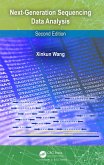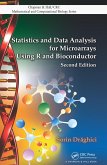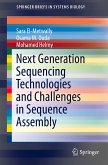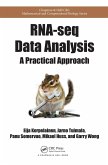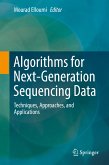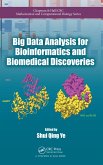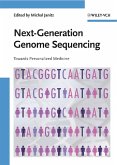Xinkun Wang
Next-Generation Sequencing Data Analysis (eBook, PDF)
86,95 €
86,95 €
inkl. MwSt.
Sofort per Download lieferbar

43 °P sammeln
86,95 €
Als Download kaufen

86,95 €
inkl. MwSt.
Sofort per Download lieferbar

43 °P sammeln
Jetzt verschenken
Alle Infos zum eBook verschenken
86,95 €
inkl. MwSt.
Sofort per Download lieferbar
Alle Infos zum eBook verschenken

43 °P sammeln
Xinkun Wang
Next-Generation Sequencing Data Analysis (eBook, PDF)
- Format: PDF
- Merkliste
- Auf die Merkliste
- Bewerten Bewerten
- Teilen
- Produkt teilen
- Produkterinnerung
- Produkterinnerung

Bitte loggen Sie sich zunächst in Ihr Kundenkonto ein oder registrieren Sie sich bei
bücher.de, um das eBook-Abo tolino select nutzen zu können.
Hier können Sie sich einloggen
Hier können Sie sich einloggen
Sie sind bereits eingeloggt. Klicken Sie auf 2. tolino select Abo, um fortzufahren.

Bitte loggen Sie sich zunächst in Ihr Kundenkonto ein oder registrieren Sie sich bei bücher.de, um das eBook-Abo tolino select nutzen zu können.
Next-Generation Sequencing Data Analysis walks readers through NGS data analysis step-by-step for a wide range of NGS applications.
- Geräte: PC
- mit Kopierschutz
- eBook Hilfe
Andere Kunden interessierten sich auch für
![Next-Generation Sequencing Data Analysis (eBook, ePUB) Next-Generation Sequencing Data Analysis (eBook, ePUB)]() Xinkun WangNext-Generation Sequencing Data Analysis (eBook, ePUB)86,95 €
Xinkun WangNext-Generation Sequencing Data Analysis (eBook, ePUB)86,95 €![Statistics and Data Analysis for Microarrays Using R and Bioconductor (eBook, PDF) Statistics and Data Analysis for Microarrays Using R and Bioconductor (eBook, PDF)]() Sorin DraghiciStatistics and Data Analysis for Microarrays Using R and Bioconductor (eBook, PDF)102,95 €
Sorin DraghiciStatistics and Data Analysis for Microarrays Using R and Bioconductor (eBook, PDF)102,95 €![Next Generation Sequencing Technologies and Challenges in Sequence Assembly (eBook, PDF) Next Generation Sequencing Technologies and Challenges in Sequence Assembly (eBook, PDF)]() Sara El-MetwallyNext Generation Sequencing Technologies and Challenges in Sequence Assembly (eBook, PDF)40,95 €
Sara El-MetwallyNext Generation Sequencing Technologies and Challenges in Sequence Assembly (eBook, PDF)40,95 €![RNA-seq Data Analysis (eBook, PDF) RNA-seq Data Analysis (eBook, PDF)]() Eija KorpelainenRNA-seq Data Analysis (eBook, PDF)68,95 €
Eija KorpelainenRNA-seq Data Analysis (eBook, PDF)68,95 €![Algorithms for Next-Generation Sequencing Data (eBook, PDF) Algorithms for Next-Generation Sequencing Data (eBook, PDF)]() Algorithms for Next-Generation Sequencing Data (eBook, PDF)73,95 €
Algorithms for Next-Generation Sequencing Data (eBook, PDF)73,95 €![Big Data Analysis for Bioinformatics and Biomedical Discoveries (eBook, PDF) Big Data Analysis for Bioinformatics and Biomedical Discoveries (eBook, PDF)]() Big Data Analysis for Bioinformatics and Biomedical Discoveries (eBook, PDF)48,95 €
Big Data Analysis for Bioinformatics and Biomedical Discoveries (eBook, PDF)48,95 €![Next Generation Genome Sequencing (eBook, PDF) Next Generation Genome Sequencing (eBook, PDF)]() Next Generation Genome Sequencing (eBook, PDF)120,99 €
Next Generation Genome Sequencing (eBook, PDF)120,99 €-
-
-
Next-Generation Sequencing Data Analysis walks readers through NGS data analysis step-by-step for a wide range of NGS applications.
Dieser Download kann aus rechtlichen Gründen nur mit Rechnungsadresse in A, B, BG, CY, CZ, D, DK, EW, E, FIN, F, GR, HR, H, IRL, I, LT, L, LR, M, NL, PL, P, R, S, SLO, SK ausgeliefert werden.
Produktdetails
- Produktdetails
- Verlag: Taylor & Francis eBooks
- Seitenzahl: 434
- Erscheinungstermin: 6. Juli 2023
- Englisch
- ISBN-13: 9781000897197
- Artikelnr.: 68109390
- Verlag: Taylor & Francis eBooks
- Seitenzahl: 434
- Erscheinungstermin: 6. Juli 2023
- Englisch
- ISBN-13: 9781000897197
- Artikelnr.: 68109390
- Herstellerkennzeichnung Die Herstellerinformationen sind derzeit nicht verfügbar.
Dr. Xinkun Wang is a research professor and the director of the Next-Generation Sequencing Facility at Northwestern University in Chicago. Dr. Wang's first foray into the genomics field was during his doctoral training, performing microarray-based gene expression analysis. From 2005 to 2015, he was the founding director of the University of Kansas Genomics Facility, prior to moving to Northwestern to head the Northwestern University Sequencing Facility (NUSeq) in late 2015. Dr. Wang is a renowned expert on genomics technologies and data mining, and their applications to the biomedical field. Besides his monographic publications, he has published extensively in neuroscience, with a focus on brain aging and neurodegenerative diseases (mostly Alzheimer's disease).
Dr. Wang has served as principal investigator on dozens of grants. Dr. Wang's other professional activities include serving on journal editorial boards, and as reviewers for journals, publishers, and funding agencies. Dr. Wang is a member of American Society of Human Genetics, Association of Biomolecular Resource Facilities, the Honor Society of Phi Kappa Phi, and Society for Neuroscience. Dr. Wang was born in Shandong province, China, and is a first-generation college graduate. His off-work hobbies include cycling and Alpine skiing.
Dr. Wang has served as principal investigator on dozens of grants. Dr. Wang's other professional activities include serving on journal editorial boards, and as reviewers for journals, publishers, and funding agencies. Dr. Wang is a member of American Society of Human Genetics, Association of Biomolecular Resource Facilities, the Honor Society of Phi Kappa Phi, and Society for Neuroscience. Dr. Wang was born in Shandong province, China, and is a first-generation college graduate. His off-work hobbies include cycling and Alpine skiing.
1. The Cellular System and The Code of Life. 2. DNA Sequence: the Genome
Base. 3. RNA: the Transcribed Sequence. 4. Next-Generation Sequencing (NGS)
Technologies: Ins and Outs. 5. Early-Stage Next-Generation Sequencing (NGS)
Data Analysis: Common Steps. 6. Computing Needs for Next-Generation
Sequencing (NGS) Data Management and Analysis. 7. Transcriptomics by Bulk
RNA-Seq. 8. Transcriptomics by Single Cell RNA-Seq. 9. Small RNA
Sequencing. 10. Genotyping and Variation Discovery by Whole Genome/Exome
Sequencing. 11. Clinical Sequencing and Detection of Actionable Variants.
12. De Novo Genome Assembly with Long and/or Short Reads. 13. Mapping
Protein-DNA Interactions with ChIP-Seq. 14. Epigenomics by DNA Methylation
Sequencing. 15. Whole Metagenome Sequencing for Microbial Community
Analysis. 16. What's Next for Next-Generation Sequencing (NGS)?.
Base. 3. RNA: the Transcribed Sequence. 4. Next-Generation Sequencing (NGS)
Technologies: Ins and Outs. 5. Early-Stage Next-Generation Sequencing (NGS)
Data Analysis: Common Steps. 6. Computing Needs for Next-Generation
Sequencing (NGS) Data Management and Analysis. 7. Transcriptomics by Bulk
RNA-Seq. 8. Transcriptomics by Single Cell RNA-Seq. 9. Small RNA
Sequencing. 10. Genotyping and Variation Discovery by Whole Genome/Exome
Sequencing. 11. Clinical Sequencing and Detection of Actionable Variants.
12. De Novo Genome Assembly with Long and/or Short Reads. 13. Mapping
Protein-DNA Interactions with ChIP-Seq. 14. Epigenomics by DNA Methylation
Sequencing. 15. Whole Metagenome Sequencing for Microbial Community
Analysis. 16. What's Next for Next-Generation Sequencing (NGS)?.
1. The Cellular System and The Code of Life. 2. DNA Sequence: the Genome
Base. 3. RNA: the Transcribed Sequence. 4. Next-Generation Sequencing (NGS)
Technologies: Ins and Outs. 5. Early-Stage Next-Generation Sequencing (NGS)
Data Analysis: Common Steps. 6. Computing Needs for Next-Generation
Sequencing (NGS) Data Management and Analysis. 7. Transcriptomics by Bulk
RNA-Seq. 8. Transcriptomics by Single Cell RNA-Seq. 9. Small RNA
Sequencing. 10. Genotyping and Variation Discovery by Whole Genome/Exome
Sequencing. 11. Clinical Sequencing and Detection of Actionable Variants.
12. De Novo Genome Assembly with Long and/or Short Reads. 13. Mapping
Protein-DNA Interactions with ChIP-Seq. 14. Epigenomics by DNA Methylation
Sequencing. 15. Whole Metagenome Sequencing for Microbial Community
Analysis. 16. What's Next for Next-Generation Sequencing (NGS)?.
Base. 3. RNA: the Transcribed Sequence. 4. Next-Generation Sequencing (NGS)
Technologies: Ins and Outs. 5. Early-Stage Next-Generation Sequencing (NGS)
Data Analysis: Common Steps. 6. Computing Needs for Next-Generation
Sequencing (NGS) Data Management and Analysis. 7. Transcriptomics by Bulk
RNA-Seq. 8. Transcriptomics by Single Cell RNA-Seq. 9. Small RNA
Sequencing. 10. Genotyping and Variation Discovery by Whole Genome/Exome
Sequencing. 11. Clinical Sequencing and Detection of Actionable Variants.
12. De Novo Genome Assembly with Long and/or Short Reads. 13. Mapping
Protein-DNA Interactions with ChIP-Seq. 14. Epigenomics by DNA Methylation
Sequencing. 15. Whole Metagenome Sequencing for Microbial Community
Analysis. 16. What's Next for Next-Generation Sequencing (NGS)?.

